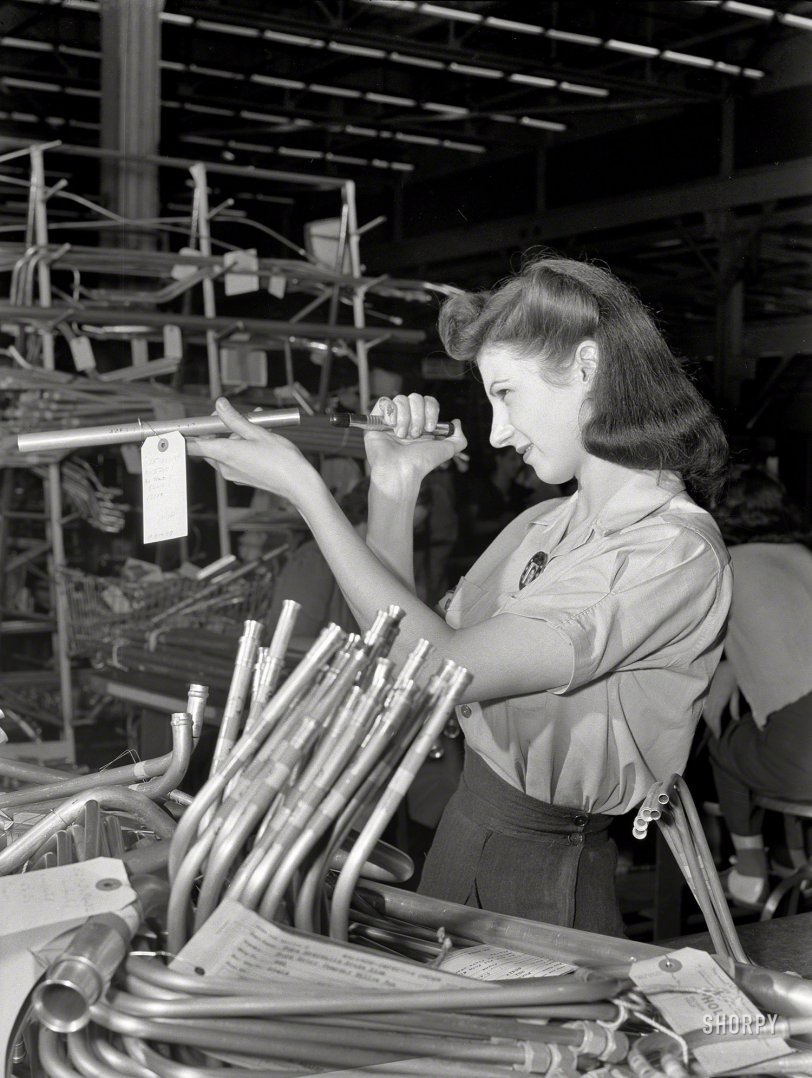


Framed or unframed, desk size to sofa size, printed by us in Arizona and Alabama since 2007. Explore now.
Shorpy is funded by you. Patreon contributors get an ad-free experience.
Learn more.

- Baldwin 62303
- Baldwin VO-1000
- Cold
- No expense spared
- Tough Guys
- Lost in Toyland
- And without gloves
- If I were a blindfolded time traveler
- Smoke Consumer Also Cooks
- Oh that stove!
- Possibly still there?
- What?!?
- $100 Reward
- Freeze Frame
- Texas Flyer wanted
- Just a Year Too Soon
- WWII -- Replacing men with women at the railroad crossing.
- Yes, Icing
- You kids drive me nuts!
- NOT An Easy Job
- I wonder
- Just add window boxes
- Icing Platform?
- Indiana Harbor Belt abides
- Freezing haze
- Corrections (for those who care)
- C&NW at Nelson
- Fallen Flags
- A dangerous job made worse
- Water Stop
Print Emporium
Tube Inspector: 1942

July 1942. "Ford bomber plant at Willow Run, Michigan. Inspection of more than a thousand separate tubing pieces composing the fuel, hydraulic, de-icing and other systems in a bomber is a highly important job. This young employee at the giant Willow Run plant uses her tiny flashlight to discover any internal defects in the tubing." Photo by Ann Rosener, Office of War Information. View full size.
Blowing a Tube
My late father was an engine mechanic on the WW2 bombers, including the B-24. I can remember him telling me stories about one the those big boys "blowing a tube." His team, which always included a female WAAC (under 100 lbs. so she could get up inside the wing), would scramble to get the plane back into the air, even if the effort involved a 24-hour shift.
Willit Run??
Willow Run was most famous for producing B-24 Liberators. Many of the B-24s were painted with nose art that poked fun at the Ford plant by calling their planes names such as "Willit Run?" "Fords Folley" "Model T" and so on. I got to know the flight engineer of "Henry's Pride" who flew 30 missions with the 446th BG on a Willow Run B-24 during the war. After his tour his assignment was to fly B-24's from Willow Run to training bases around the country though never back overseas.
Keep Em Flying
And that's what I work in, as a QI as well as QE and other technical positions in the aerospace field, by the way the proper way to inspect tubing is to look at each end, she's probally looking at one end at the moment the photo was taken. Fuel & hydraulic tubing would be considered flight critical items and need close attention in inspecting them.
Wrong End
I don't mean to nit-pick, but the light should be at the other end. Maybe this version was just for the camera, but...
Choosing the model
The photographer probably made the decision, who would he (in this case, she) feature in the shot. Almost all of the WW2 era home front pictures starred good looking women and there was probably a pretty good sized pool to choose from. These photos were recruiting tools for the factories as well as morale boosters for the general public.
Good Eyes
She must have good eyes to see around the bends in the tubing.
Later
My mother worked for the Environmental Research Institute of Michigan (ERIM) in the 1970's. It was housed in part of the old Willow Run plant. When she was there, they apparently hadn't changed much of the interior of the building apart from tacking on some offices; she always recognizes it in old photos, even ones taken during the war.
PIP
Picture in a picture -- you can see her photo ID in the field of focus (as well as the writing on a tube tag or two that is in the field of focus).
Photo Prop
She is just holding a photo prop. The color coded tubes by her left elbow are the ones she is supposed to be inspecting.
"Tubing:
Amount used, 278 feet rubber; 3,300 feet metal. 1,800 tubes in ship; 12 systems... Approximately 25,000 tubes bent and marked with identification tape daily."
"Willow Run: Colossus of American Industry"
Warren Benjamin Kidder, pp.303-304
Willow Run
Most likely the tubes are for B-24s, if I remember correctly.
Very nice
She looks amazing after just finishing a 12 hour shift.
Neatness counts
I am always amazed how clean and neatly dressed the war workers are. My Mother left Kentucky to work at Willow Run.
Pretty Girls
What's a gal gotta do to make the category?
Real Backbone!
This young lady, despite her clean and pressed clothing, is not afraid to get her hands dirty (note the smudge on her right pinky finger; maybe dirt, rust, blood?). No fancily manicured "french" nails here.
The war years really showed America what women could do!
























On Shorpy:
Today’s Top 5